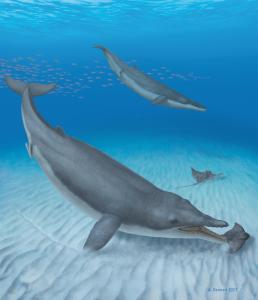
Two Mystacodon selenensis individuals diving down to catch eagle rays. (Image by Alberto Gennari)
Scientists finally found the missing evolutionary link between the modern whales’ toothed ancestors, the basilosaurids, and the filter-feeding mysticetes, which include the blue whale, the humpback whale, and the right whale. A recent paper describes a 36.4-million-year-old whale fossil with teeth and small vestigial hind limbs, which also help connect it to the whales’ ancient land-dwelling ancestors. Despite having teeth, the specimen—dubbed Mystacodon—had a mouth better suited for sucking in small animals and bottom-feeding rather than biting. Both of these behaviors can be observed in modern baleen whales, in whom the teeth have long been replaced with keratin fibers which allow them to trap the small prey. Mystacodon discovery helps fill the important evolutionary step that turned whales from active predators into filter feeders.
Authors:
Olivier Lambert, Manuel Martínez-Cáceres, Giovanni Bianucci, Claudio Di Celma, Rodolfo Salas-Gismondi, Etienne Steurbaut, Mario Urbina, Christian de Muizon
Corresponding author:
Olivier Lambert, Royal Belgian Institute of Natural Sciences, Email: olivier.lambert@
Original paper published in Current Biology on May 11, 2017.

